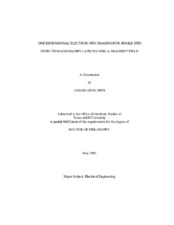| dc.contributor.advisor | Hemmer, Philip | |
| dc.creator | Shin, Chang-Seok | |
| dc.date.accessioned | 2010-01-15T00:10:21Z | |
| dc.date.accessioned | 2010-01-16T00:53:06Z | |
| dc.date.available | 2010-01-15T00:10:21Z | |
| dc.date.available | 2010-01-16T00:53:06Z | |
| dc.date.created | 2008-05 | |
| dc.date.issued | 2009-05-15 | |
| dc.identifier.uri | https://hdl.handle.net/1969.1/ETD-TAMU-2731 | |
| dc.description.abstract | The ability to resolve molecules individually has many potential applications.
These include understanding the local environments of single molecules including
details of their interactions with surroundings. The ability to individually address and
manipulate the spin states is also required for spin based quantum information
processing. Although optical detection techniques, such as optically detected electron
spin resonance (ESR) seem very powerful in these contexts, multiple molecules in the
focal volume of a diffraction limited confocal microscope spot cannot in general be
resolved individually. Here we propose to solve this problem using optically detected
ESR imaging based on the use of high field gradients.
In the present research, subwavelength single molecule imaging is demonstrated
by using the optically detected ESR technique and the optically detected electron spin
echo envelope modulation (ESEEM) technique. Ultra fast Rabi nutation experiments
are also performed to demonstrate the feasibility of fast spin manipulations at a low
microwave power. Micrometer sized gradient coils, together with micrometer sized co-planar
microstrip transmission lines, are designed and fabricated by optical lithography in order
to produce the necessary high magnetic field gradients. These fabricated devices are
used to demonstrate this subwavelength imaging technique by imaging single electron
spins of the nitrogen-vacancy (NV) defect in diamond. In this demonstration, multiple
NV defects, unresolved in a single focal volume of a diffraction limited microscope are
successfully resolved by the optically detected ESR techniques. Specifically, two
neighboring NV defects separated by about 170nm are resolved. Ultra Fast electron
spin nutation with an oscillation period of 1.33ns is also achieved by the high microwave
magnetic field induced by the current flowing through the fabricated co-planar
microstrip lines.
These optically detected ESR and ESEEM techniques combined with the
micrometer sized gradient coil may find many applications, including single molecule
imaging and quantum information processing. | en |
| dc.format.medium | electronic | en |
| dc.format.mimetype | application/pdf | |
| dc.language.iso | en_US | |
| dc.subject | ESR | en |
| dc.subject | subwavelength imaging | en |
| dc.subject | Single spin detection | en |
| dc.subject | Single spin manipulation | en |
| dc.subject | quantum information processing | en |
| dc.title | One dimensional electron spin imaging for single spin detection and manipulation using a gradient field | en |
| dc.type | Book | en |
| dc.type | Thesis | en |
| thesis.degree.department | Electrical and Computer Engineering | en |
| thesis.degree.discipline | Electrical Engineering | en |
| thesis.degree.grantor | Texas A&M University | en |
| thesis.degree.name | Doctor of Philosophy | en |
| thesis.degree.level | Doctoral | en |
| dc.contributor.committeeMember | Eknoyan, Ohannes | |
| dc.contributor.committeeMember | Laane, Jaan | |
| dc.contributor.committeeMember | Nevels, Robert | |
| dc.type.genre | Electronic Dissertation | en |
| dc.type.material | text | en |
| dc.format.digitalOrigin | born digital | en |


